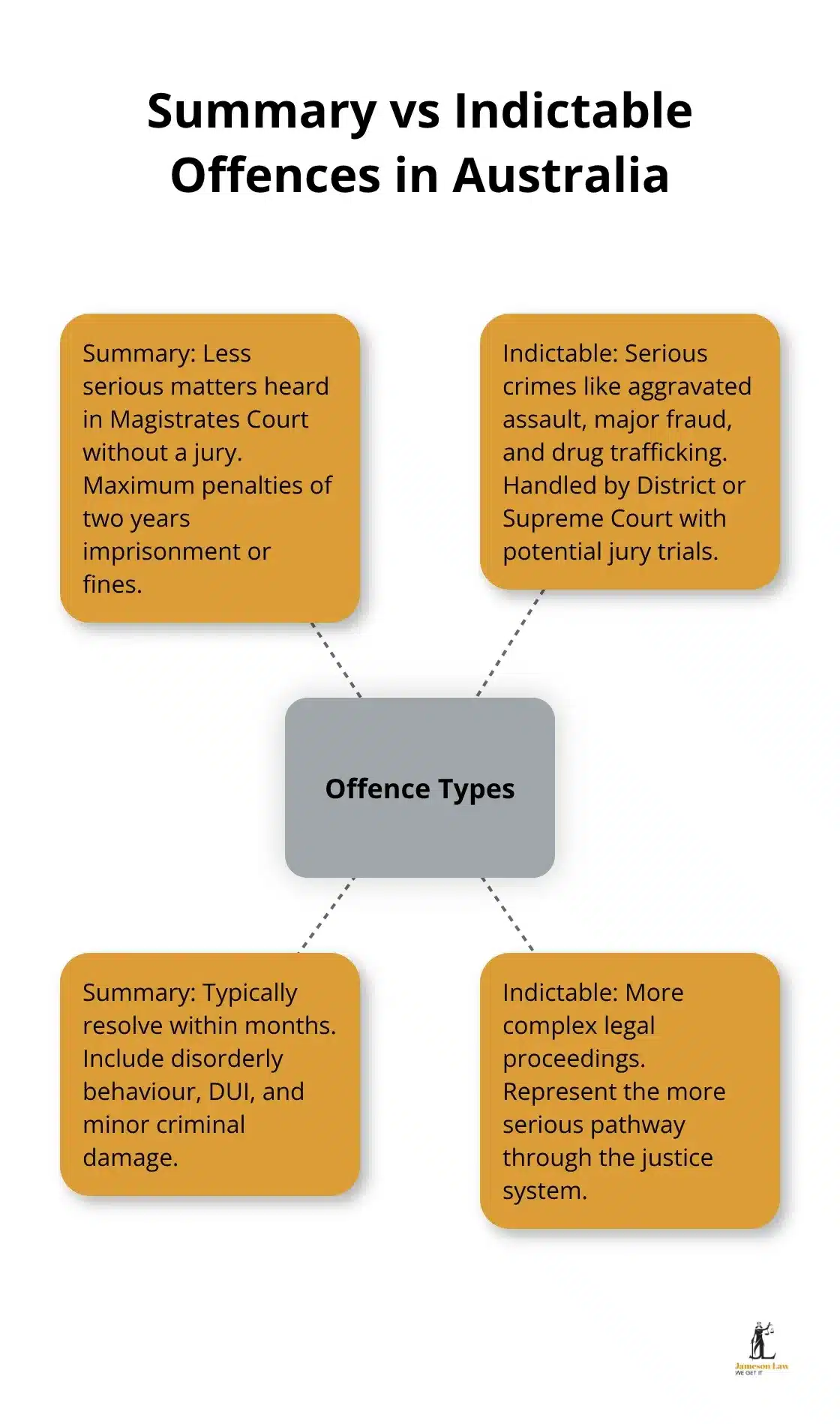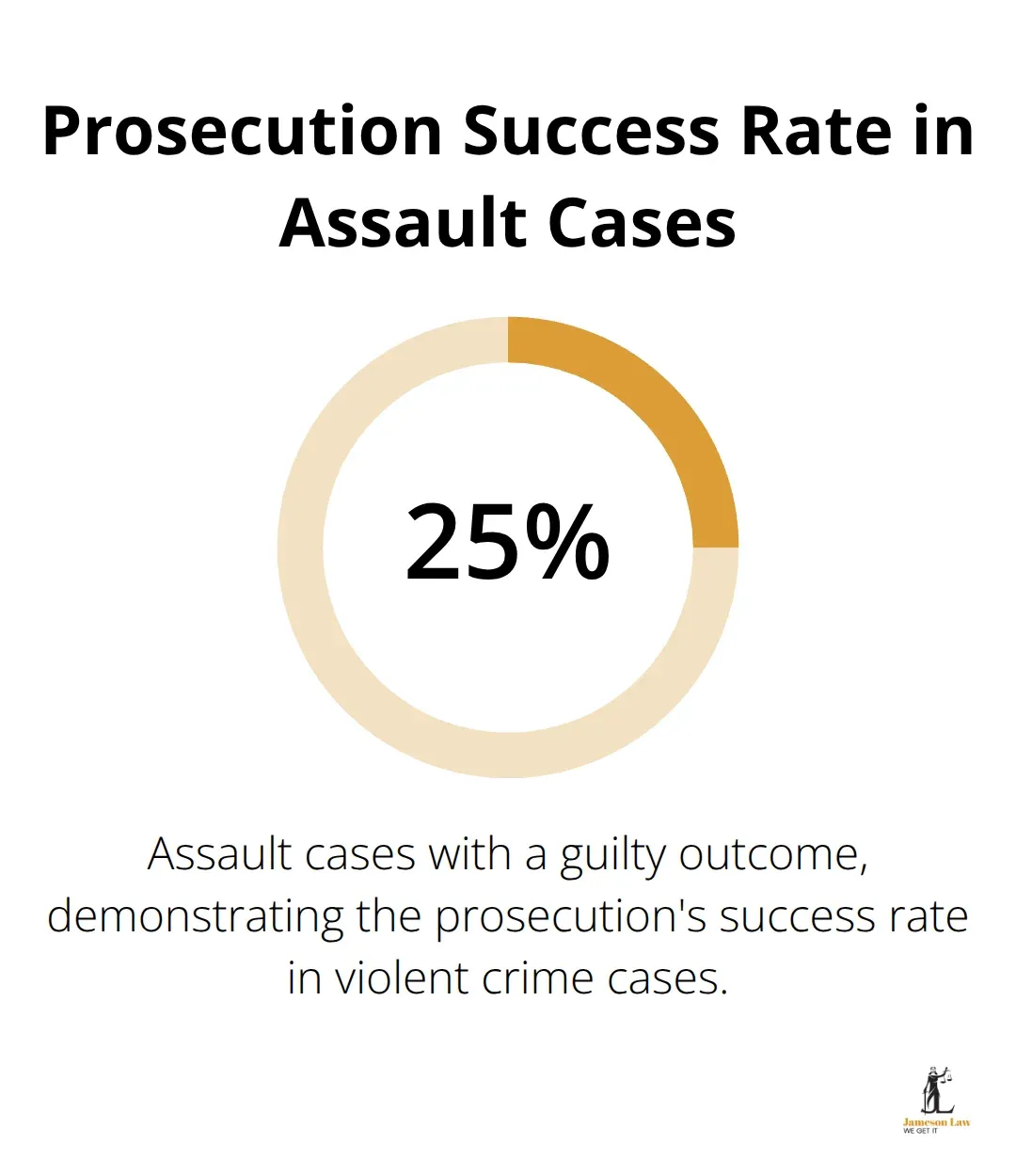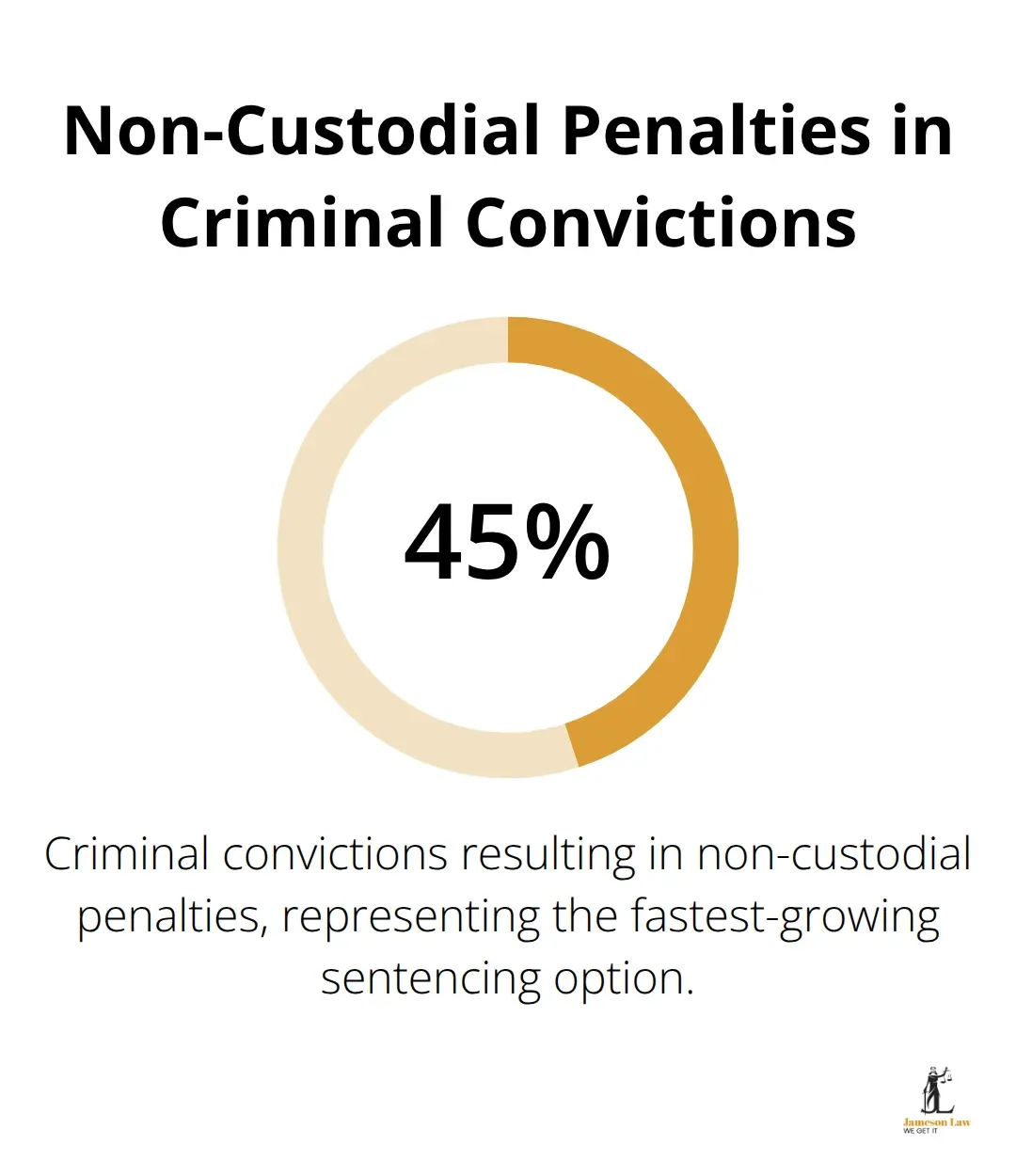Australia’s criminal justice system categorises offences through distinct criminal law types that determine how cases proceed through court. Each classification carries different penalties and procedural requirements.
We at Jameson Law see clients navigate these complex legal distinctions daily. Understanding these categories helps defendants and their families prepare for what lies ahead in the criminal justice process.
How Are Criminal Offences Classified in Australia
Summary Versus Indictable Distinctions
Australian criminal law operates through a two-tier classification system that directly impacts how your case proceeds through court. Summary offences represent less serious matters that the Magistrates Court hears without a jury. These include disorderly behaviour, driving under the influence of alcohol or a drug, and minor criminal damage to property. These cases typically resolve within months and carry maximum penalties of two years imprisonment or substantial fines.
Indictable offences encompass serious crimes like aggravated assault, fraud over $100,000, and drug trafficking. The District or Supreme Court handles these matters with potential jury trials. These represent the more complex pathway through the justice system requiring extensive legal proceedings.

Commonwealth Powers Versus State Jurisdiction
The division between Commonwealth and state criminal matters creates a complex legal landscape where jurisdiction determines which laws apply and which court hears your case. Commonwealth offences include tax evasion, immigration violations, cybercrime, and drug importation. Federal legislation governs these crimes and typically imposes harsher penalties, with some serious offences like drug importation carrying maximum penalties of life imprisonment.
State matters cover assault, theft, driving offences, and domestic violence. Individual state criminal codes govern these offences. This jurisdictional split means identical actions can face different penalties based on circumstances. For example, fraud against a federal agency attracts Commonwealth charges with potential 10-year sentences, while similar fraud against private businesses falls under state law with lesser maximum penalties.
Court Hierarchy and Offence Severity
The court system reflects the severity of criminal classifications through its hierarchical structure. The Magistrates Court handles summary offences and some minor indictable matters (those that can be heard summarily). The District Court manages serious indictable offences including major fraud, serious assault, and drug trafficking cases. The Supreme Court reserves jurisdiction for the most severe crimes such as murder, manslaughter, and major commercial fraud.
This hierarchy affects more than just where your case appears. Higher courts impose longer sentences, have more complex procedures, and require greater legal expertise to navigate effectively. The classification of your offence determines not only potential penalties but also the complexity and duration of legal proceedings you face.
These classifications form the foundation for understanding how different criminal matters progress through Australia’s justice system, which directly influences the penalties and legal strategies available in each case type.
What Criminal Offences Face the Harshest Penalties
Violent Crimes Carry Mandatory Prison Terms
Violent offences represent the most serious criminal matters in Australia’s justice system, with homicide attracting the harshest penalties available. Murder convictions result in mandatory life imprisonment in most Australian jurisdictions, while manslaughter carries maximum sentences ranging from 20 to 25 years depending on the state. A quarter of those with a guilty outcome for assault cases demonstrate the prosecution’s success rate in violent crime cases.

Assault charges span multiple severity levels with dramatically different consequences. Common assault carries maximum penalties of two years imprisonment, while grievous bodily harm with intent can result in up to 25 years in NSW courts. Aggravated assault involving weapons or vulnerable victims attracts sentences between five and 14 years. These classifications matter significantly because courts rarely impose suspended sentences for serious violent crimes.
Property Crimes Generate Billions in Annual Losses
Theft and burglary offences create substantial financial impact across Australia, with property crimes costing the economy billions annually according to government statistics. Residential burglary attracts higher penalties than commercial break-ins, with maximum sentences reaching 14 years for aggravated home invasions. Motor vehicle theft carries penalties up to 10 years, while shoplifting typically results in fines or short prison terms under two years.
The distinction between theft categories affects sentencing outcomes dramatically. Stealing property worth under $5,000 often results in community service or fines, while theft exceeding $60,000 triggers serious indictable charges with potential multi-year prison sentences. Courts consider the value stolen, planning involved, and impact on victims when determining penalties.
White Collar Crime Penalties Exceed Many Violent Offences
Fraud and financial crimes now attract some of Australia’s longest prison sentences, reflecting the serious economic harm these offences create. Reports show fraud losses totalled over $10 million, driving courts to impose increasingly severe penalties. Major fraud exceeding $100,000 can result in sentences up to 10 years, while complex corporate fraud schemes attract penalties reaching 15 years imprisonment.
Tax evasion through the Australian Taxation Office generates particularly harsh consequences, with maximum penalties of 10 years imprisonment plus substantial financial penalties. Identity theft and cybercrime carry sentences up to seven years, with courts showing little tolerance for technology-based offences that target vulnerable victims or compromise personal data.
Understanding these penalty structures helps defendants and their families prepare for potential outcomes, but the actual sentence depends heavily on how courts weigh various factors during the sentencing process.
How Do Courts Determine Criminal Penalties
Maximum Penalties Reflect Crime Severity
Australian courts operate within statutory maximum penalties that Parliament sets for each offence type. These limits create a framework where judges impose sentences up to these maximums. Murder carries life imprisonment across all jurisdictions, while manslaughter reaches 25 years in NSW and Victoria. Aggravated robbery attracts maximum terms of 20 years, compared to simple theft under $5,000 which typically results in two years maximum imprisonment. Courts rarely impose these statutory maximums except for repeat offenders or cases with extreme circumstances.
Drug trafficking penalties escalate dramatically based on quantities involved. Commercial quantities of cocaine or heroin trigger maximum sentences of 20 years imprisonment and/or 5,000 penalty units for large commercial quantities, while small amounts for personal use result in fines or community orders. Courts impose substantial sentences for major drug crimes based on the quantities and circumstances involved.
Judicial Discretion Shapes Actual Sentences
Courts weigh specific factors when they determine sentences within statutory limits. Prior criminal history carries the greatest influence on outcomes. First-time offenders typically receive sentences at the lower end of available ranges, while repeat violent offenders face penalties that approach maximum terms. Offenders with multiple prior convictions receive significantly longer sentences than first-time offenders for identical crimes.
Victim impact statements significantly influence court decisions, particularly in violent crime cases where physical or psychological harm occurred. Courts also consider guilty pleas, with early admissions of guilt typically reducing sentences by 10-25%. Co-operation with police investigations and expressions of genuine remorse further reduce penalties. Lack of remorse or attempts to blame victims increase sentences toward maximum available terms.
Non-Custodial Options Avoid Prison Time
Community-based orders represent the fastest-growing sentencing option. Recent court statistics show 45% of criminal convictions now result in non-custodial penalties. These include community service requirements, good behaviour bonds, and intensive supervision orders that allow offenders to remain in the community while they serve their sentence. Home detention with electronic monitoring serves as an alternative to imprisonment for non-violent offenders (particularly those with employment or family responsibilities).

Suspended sentences allow courts to impose prison terms that activate only if the offender commits further crimes within specified periods. Courts frequently combine these options. They order community service plus victim compensation payments for property crimes, or intensive supervision with mandatory counselling for domestic violence offences. These alternatives cost taxpayers significantly less than imprisonment while they maintain public safety through supervision and rehabilitation requirements.
Final Thoughts
Criminal law types and their classifications become vital when you face charges in Australia’s complex justice system. The distinction between summary and indictable offences, Commonwealth versus state matters, and the severity of different crime categories directly impacts your legal strategy and potential outcomes. Criminal charges carry serious consequences that extend beyond immediate penalties and affect employment prospects, travel opportunities, and professional licences.
The court system shows little mercy to those who attempt to navigate these waters without proper legal guidance. We at Jameson Law recognise that criminal matters require immediate attention and expert knowledge. Our experienced criminal law team understands how different offence classifications affect case outcomes and available options (including alternative sentences that avoid imprisonment).
Early legal intervention often determines the difference between conviction and acquittal, or between imprisonment and alternative options. Jameson Law offers comprehensive criminal law services across NSW, helping clients understand their rights and build strong defences against all types of criminal charges. Contact us today to discuss your specific situation and protect your future.













